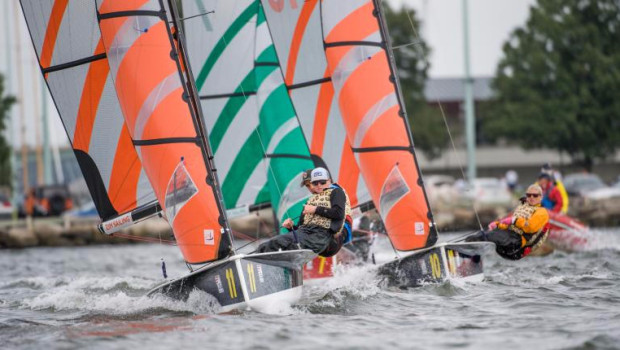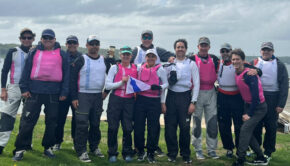Team Racing: Short and Sweet
Published on November 2nd, 2015
Tom Donlan shares this story in the October 2015 issue of Spinsheet magazine, the publication for boaters and sailors of all levels on the Chesapeake Bay…
Sail-racers have heard how their sport is like watching grass grow, and most will admit there’s some truth to it. Fleet racing is slow: The races last for hours, spread out over a wide area, and are conducted in complicated, expensive boats. Often nobody knows who’s ahead and who’s behind until the finish, if then. There may be protests to resolve or handicaps to compute, or both.
Team races, on the other hand, are short—15 to 30 minutes—and provide almost continuous action, with as many as 10 fresh starts during a day of racing. Although team racing puts a high premium on using the rules aggressively, confrontations on the race course are settled by umpires, who make quick rulings that can’t be appealed.
A team usually has three boats, making for a race of six boats. During the race, place means little and position means everything. The only goal in a six-boat race is to achieve a three-boat score of 10 or less. It is less like a horse race and more like a football game, in which position and teamwork are required for success.
The most successful clubs and schools sponsoring team racing have their own boats and sponsor intensive practices for their sailors. Annapolis YC (AYC) has acquired six used J/22s for an adult team racing program, and it was selected to host the U.S. Sailing Team Race Championship, for the Hinman Trophy, September 25-27.
Dillon Paiva, 24, former director of the AYC junior program, explains that team racing requires intense practice that prepares sailors for tight maneuvering and quick thinking—not so often required in fleet racing out in the middle of the Bay.
Unlike fleet racing, in which the trophies usually go to the most talented sailors, team racing success goes to the teams that practice hardest.
“It’s often hard to figure out why you did well or poorly in a fleet race, says Paiva. “Often it turns out to be natural skill or feel for the boat that people are born with.” By contrast, says Paiva, in a team race, “all it takes is three boats with decent crew who work well together and are willing to practice.”
In racing of this type, on-the-water umpiring is essential. Without umpires, the protest hearings would go on forever. Umpires provide nearly instant decisions, and there’s just a one-turn penalty in most cases so that the racers can focus on racing.
The sport needs a lot of umpires. Two umpires per boat on three chase boats—to say nothing of three chaseboat drivers—make for the best team race events.
Jim Capron, an experienced umpire and international judge, says it takes special technique to be a good team race umpire. The umpire must know the rules cold, of course, but he or she also must cultivate the ability to see what conflicts are coming.
“I don’t know any good umpires who haven’t been racing sailors,” Capron says. And if they haven’t been team racers themselves, they must study the special rules and techniques that teams are using.
The International Sailing Federation publishes a ‘Call Book for Team Racing that documents dozens of possible racing conflicts and explains how umpires should call them. Umpires can be sure that good team racers know the book; they must know it just as well.
For the October 2015 issue, click here.









 We’ll keep your information safe.
We’ll keep your information safe.